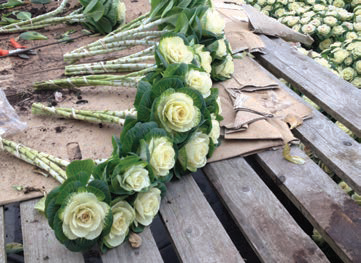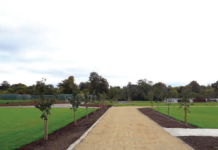In a continuing series of articles on cut flowers, Andy Whelton of Teagasc Horticultural Development Department looks at the potential of Brassica oleracea which is gaining popularity in the trade
Whilst cabbage is firmly established as one of the recommended portions of our five-a-day fruit and veg, there is now an increasing appetite from supermarkets and florists for single stems of specially bred cultivars of Brassica oleraceae where they are used as fillers in mixed flower bouquets.
Experimental work carried out by Teagasc suggests that planting from mid-June (out of doors) to early/mid-August (under protection) will give continuity of cropping from September to February. The basic requirements are no different to growing edible brassicas where deep, well-drained soils of pH 6.5 to 7.0 are preferred. The crop is generally grown on the flat. A soil test is necessary to accurately determine rates of Phosphorus and Potash. The species will respond to the use of Nitrogen when up to 100 kg/ha can be applied depending on previous crop history. A sterilised soil is recommended for weed control in the protected crop. Standard herbicides used in edible production can be used in the outdoor crop.
There is a wide selection of varieties available in all sorts of colours, shapes, textures but the Teagasc work concluded that the Crane series of ‘Red’, ‘White’ and ‘Rose’ cultivars is currently the most popular and of these ‘Red’ is in the greatest demand.
GET THE PLANT DENSITY RIGHT
While the crop can be direct drilled, work to date has been on using transplants where plants are generally raised from seed sown in modules during April/May. Plants are planted in single rows at 80m2. This gives an overall plant density of about 650,000 plants per ha, leaving space at intervals to facilitate management and harvesting operations. A wire mesh is used to give support to the crop as it grows. This is put in place at planting and raised up as the plants grow with the aid of specially adapted poles. This prevents the growth of curved stems which are unacceptable in the trade. The flower heads must not be oversized and if planted too close they will be too small or they will not develop properly.
PEST & DISEASE CONTROL PROGRAMME VITAL
The normal pests of brassicas must be monitored for, including cabbage root fly, aphids and caterpillars. Insecticide treatments are justified during the growing season. Slugs can also be a threat. Experience with outdoor production suggests that rabbits and pigeons could also affect quality and yield. The main diseases to look out for include downy mildew, ring spot and alternaria. A fungicide programme must be implemented and regular spraying is justified.
Experience suggests that the crop should be well watered and fertilised in the first three to four weeks of growth so that adequate stem length is attained. The heads begin to colour at lower temperatures in autumn when night temperatures drop below 150C. The plants need five to six days of cold nights to change colour.
When the top of the stems has coloured up to the desired tone, good quality unblemished stems, at least 55cm in length are carefully selected and cut using hand-held secateurs.
Grading and bunching are generally carried out in the packing shed. The lower leaves are removed and stems are tied neatly with a rubber band in bunches of 10, then left standing in water overnight and kept cool prior to packing or further transport in buckets on Danish trolleys.
Experience to date suggests a net return of €4.50 per m2 (€45,000 per ha) is achievable from a single crop under protection given a 60% grade out. It is assumed that a structure is already in place. The cost of the support poles and netting is estimated at €14,000/ha which is an additional capital cost to bear in mind. Further information at: www.teagasc.ie/crops/horticulture/cut-foliage. ✽
  |








